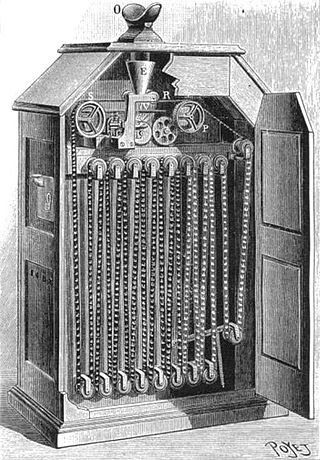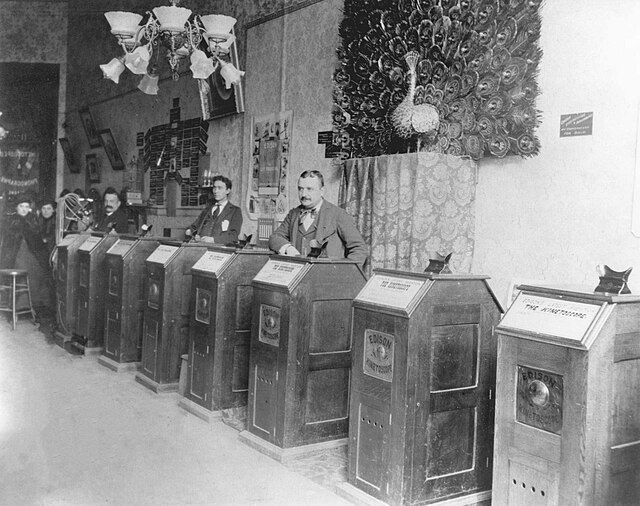活動電影放映機
来自维基百科,自由的百科全书
活動電影放映機(Kinetoscope)是一種早期電影顯示設備,由湯瑪斯·愛迪生申請專利(並非發明),器件被放置在一個櫥櫃裏,只能允許一個人通過小窗口觀看電影。活動電影放映機引入了電影放映的基本方法,該方法於影片發明前被所有電影放映機採用。它通過在一個光源前高速轉動帶有連續圖片的電影膠片條,從而產生運動的錯覺。1888年美國發明家湯瑪斯·愛迪生最早提出這個概念,後來他的員工威廉·甘迺迪·迪克森在1889年和1892年之間極大程度地發展了這個技術。迪克森和他在愛迪生實驗室的團隊也同時設計了活動電影攝影機,這是一個創新的電影攝影機,可以連續地拍攝圖像。在內部試驗拍攝電影後,商業的活動電影放映機最終誕生了。

1894年4月,第一場歷史性的商業電影放映在紐約舉行,一共使用了10台活動電影放映機。作為美國電影文化誕生的機器,活動電影放映機在歐洲也引起了轟動。愛迪生決定放棄申請此設備的國際化專利,使其影響力在全球進一步擴大,出現了數量眾多的仿製品,相關技術也得到了很大的提高。1895年,愛迪生發明有聲活動電影機。這是一個將活動電影放映機和圓筒唱片留聲機結合起來的設備。而受到愛迪生藐視的電影放映機則很快取代了活動電影放映機。愛迪生的公司後來研製的許多放映機設備依舊使用「活動電影放映機」這個名字。
發展

一個偶然的機會,攝影先驅埃德沃德·邁布里奇的產品和構思似乎啟發了愛迪生開始研究電影系統。1888年2月25日,邁布里奇在新澤西西奧蘭治舉辦講座,其中可能包括一種稱為「動物實驗鏡」(Zoopraxiscope)的放映機的示範,這种放映機將連續圖像繪製在一塊玻璃圓盤的邊緣,隨着玻璃的旋轉,將影像投射出去,這樣就使這些影像顯得像在運動。愛迪生的公司就在附近,很有可能愛迪生本人和他公司的攝影師威廉·迪克森雙雙參加了這個講座。兩天後,邁布里奇與愛迪生在愛迪生位於西奧蘭治的實驗室會面,邁布里奇後來描述了他如何提議將他的設備和愛迪生的留聲機結合起來,這樣組合起來的系統可以同時播放聲音和圖像。[1]這項合作沒有進行,然而在1888年10月,愛迪生遞交了一份申請,和美國專利及商標局一起宣佈他準備創造一個機器,這個機器的目的是為了眼睛,就像留聲機的目的是為了耳朵一樣。並明確表示這個設備是一個完整的視聽系統的一部分:「我們可以觀看並且聆聽一個完整的歌劇,完美得就像現場演奏一樣。」[2]1889年3月,第二份申請也通過了,提議播放電影的設備為「Kinetoscope」(活動電影放映機),該詞來源於希臘詞根「kineto」(活動)和「scopos」(觀看)。
愛迪生任命他最有才華的員工之一——迪克森負責將活動電影放映機研製出來。儘管愛迪生本人將享有全部發明權,歷史上的輿論認為發明者很難歸功於一人:
| “ | 儘管愛迪生看起來是構思了創意並啟動了實驗,然而迪克森顯然是完成大部分試驗的人,因此現代學者認為把構想變成實際產品的主要榮譽應歸於迪克森。愛迪生實驗室是一個合作機構。實驗室的助手被安排很多項目,這些項目在愛迪生的監管之下,他本人還不同程度親自參與一些項目。[3] | ” |
迪克森和他的首席助手查爾斯·布朗(Charles Brown)起初進展緩慢。愛迪生最初的設想包括錄製寬僅1/32英寸的照片,直接放在一個圓筒上;圓筒由不透明的材料製成作為正極,或者由玻璃製成作為負極,塗上一層硝棉膠作為攝影基底。[4]另一個聲學的圓筒在圖像播放時提供同步的聲音。在試驗時,當圖像寬度擴展到1/8英寸的時候,圓筒上使用的溴化銀感光乳劑呈現的粗略效果變得不可接受。1889年6月,實驗室開始採用約翰·卡爾巴特(John Carbutt)提供的感光賽璐珞片,這種材料可以裹在圓筒上,提供一個效果大大優於以前的攝影基底。[5]為活動電影放映機製作的首部影片,也是美國的第一部電影,可能就在那時誕生了(目前關於具體的日期到底是1889年6月還是1890年11月,仍沒有定論),片名為《惡作劇第一部》(Monkeyshines, No. 1),展現了一個實驗室的員工身體靈活,表情搞笑的樣子。[6]而同步聲音的試驗則暫時押後,因為迪克森同時還在進行唱片展覽會的設計工作。[7]

很快,這個項目轉向產品化方向,主要是因為愛迪生於1889年8月初出發前往巴黎參加世界博覽會。[8]在他旅行的兩個月中,愛迪生拜訪了法國科學家和攝影學家艾蒂安-朱爾·馬雷,馬雷設計了攝影槍,這是一種可移動的能連續攝影的設備,一秒能拍12張連續的照片。[9]返回美國途中的11月2日,愛迪生申請了另一項專利,描述了一種新的活動電影放映機 ,不光是一個移動的照相膠片,並且膠片的邊上打孔,可以與齒輪匹配,這樣機械設備的運行就更平滑和可靠。[10]第一個打孔圖像設備是光學影戲機(Théâtre Optique),法國發明家夏爾-埃米爾·雷諾於1888年申請了專利。雷諾的系統沒有用到照相膠片,而是把圖像畫到膠片上。[11]在展覽會上,愛迪生同時見到了光學影戲機和德國發明家奧塔馬爾·安許茨(Ottamar Anschütz)設計的電動快速視鏡(electrical tachyscope)[12]這個投影設備通常被認為是活動電影放映機重要的設計來源。它的關鍵革新在於應用了視覺暫留原理, 通過一個間歇的光源使每一幅圖像暫時「停留」,以達到使觀看者保存許多不同圖片的詳細信息的目的,這樣就可以有效地產生持續活動的假像。1890年代後期,間歇的光源成為活動電影放映機設計的一部分。
愛迪生實驗室何時開始研究幻燈影片至今仍有爭議。根據迪克森的描述,1889年的夏天,他開始將卡爾巴特提供的堅硬的賽璐珞片切割成適合機器使用的長條;8月份,他參加了喬治·伊士曼新的柔韌性薄膜的展示,並且得到了伊士曼的許可,將之運用到機器的試驗中。[13]歷史學家瑪爾塔·布朗(Marta Braun)認為,伊士曼的產品
| “ | 有足夠的硬度並且薄,柔韌性強,適合鏡頭後的電影膠片以一個相當快的速度做間歇性的移動,在張力大的情況下不會斷裂……解決了電影發明的重要問題。[14] | ” |

一些學者,如戈登·亨德里克斯(Gordon Hendricks)則認為實驗室開始研製膠片電影機器的時間要晚得多,迪克森和愛迪生故意將發明的時間提前是為了保護專利和技術地位。不管怎樣,電影史學家戴維·魯賓遜(David Robinson)認為是1890年底才開始進行試驗,比1889年9月晚了很多,實驗室在拿到伊士曼的產品後將試驗的優先級調到最高。[15]1890年大部分時間活動電影放映機的研究進展很慢,主要是因為迪克森在5月到11月之間將精力集中在磨礦機上,這是一個愛迪生不成功的研究方向,而這段時間內沒有任何時間花費在研製活動電影放映機上。[16]1891年初,迪克森與他的新助手威廉·海斯(William Heise)以及另一個實驗室的員工查爾斯·凱澤(Charles Kayser)一起成功地設計了一個基於膠帶的電影觀看系統。在新的設計中,機器被封裝在一個木質的櫥櫃中,19毫米寬的膠片繞一組輪軸運轉。膠片邊上有一排穿孔,由電力驅動的齒輪帶動膠片,靠近一個放大的鏡頭連續傳動。[17]一個電燈在膠片的後方,將圓形的圖像投射到鏡頭上,從那裏傳到一個位於櫥柜上方的窺孔。根據魯賓遜的描述,一個快速旋轉的小門使光線閃動的時間非常短暫,每幅圖像看起來是凝固的,由於視覺的暫留性,似乎圖像在移動。[18]實驗室同時研製出電動的攝影機──活動電影攝影機,用來拍攝新的影片。為了達到電影的連續運動的效果,膠片條必須可以停下來足夠長的時間,這樣每一幅圖像可以完全曝光,並且可以快速(1/460 秒)前進到拍攝下一幅圖像。這是第一個可以高速停止和前進的電影系統,是下一個世紀電影技術的基礎。[19]

1891年5月20日,大約150名國際婦女協會的成員觀看了《迪克森的問候》這部影片,這是活動電影放映機第一次公開展出。紐約的《太陽報》報道了她們在「小盒子」裏看到的內容:
| “ | 在盒子的上方是一個大約直徑為一英寸的小孔。通過這個小孔,他們看到一個男人的照片。這是一張很不尋常的照片,他以最自然和優雅的動作彎腰微笑,揮動他的手並且脫下帽子。每一個動作都很完美……[20] | ” |
這個男人就是迪克森,這部電影一共大約3秒長。8月24日,三個詳細的專利申請被提交:第一個是活動電影攝影機,第二個也是與攝影機有關,第三個是展示運動物體照片的設備。[21]在第一個活動電影攝影機的申請中,愛迪生陳述,「我已經可以用一個照相機和膠捲以每秒46幅照片的速度拍攝……但是我不希望限制我的發明在如此高的速度……因為有些物品以每秒30幅的速度甚至更低速度都已經足夠。」[22]實際上,根據國會圖書館的存檔,歷史學家查爾斯·馬瑟(Charles Musser)認為,《迪克森問候》和其它至少兩部1891年用活動電影攝影機拍攝的短片的速度都是小於每秒30幅,甚至更低。[23]活動電影放映機的申請中還包括了一個立體電影投影的計劃,後來被廢棄。[24]
次年春天,投幣系統的研究起步,增加了一個五美分的投幣孔,也是系統機械裝置的一部分。[25]到了秋天,活動電影放映機的設計基本完成。膠片最初採用伊士曼的產品,從1893年4月起,改用紐約貝理雅相機公司的產品,膠片寬度為35毫米(1 3/8 英寸),矩形的圖像垂直順序排列,每幅圖像兩側各有四個孔。[26]在接下來幾年中,膠片的寬度被全球採用,並作為電影的標準,直到今天。1892年10月出版的《Phonogram》表明活動電影攝影機可以連續拍攝圖片,用新的膠片製作電影。[27]至於活動電影放映機,提供關鍵性的連續效果的快門的位置還有明顯爭議。根據發明家赫爾曼·卡斯爾(Herman Casler)的一份報告(亨德里克斯認為該報告是權威的,他個人試驗了5-6個至今仍保存的第一代的設備),「就在膠片上方,有一個具有五個輪輻的快門,就在膠片前打開一個很小矩形框。一盞微微閃光的燈……位於膠片的下方……光線穿過膠片,快門打開,鏡頭放大……投放在箱子上方觀看者的眼中。」[28]魯賓遜則有相反的意見,他認為快門只有一片,中間裂開,並且位置在燈和膠片中間。[18]卡斯爾-亨德里克斯的描述與1891年公司活動電影放映機專利申請書上的原理圖相符,尤其是原理圖2。專利書並沒有描繪出快門,但是表現出有可能放在燈和膠片中間,這樣就不需要重大的設計修改,並且在膠片和鏡頭中保留了一個空間適合放快門。[29]魯賓遜的觀點,則與亨德里克斯所著的書中的一幅活動電影放映機的內部構造照片相符。[30]
1893年2月21日,活動電影攝影機膠片持續運動的控制系統的專利被通過。[31]幾年後,競爭對手的系統取代了這個機械制動的機器,尤其是那些基於「馬耳他十字」的機器漸漸成為攝像機和放映機的標準。 [32]3月14日,活動電影攝影機可以持續觀看的專利最終獲得通過,專利號493,426。[33]活動電影攝影機公佈於眾的日子到了。
公佈於眾

完整的活動電影放映機的首次展出並不是在最初設想的1893年芝加哥哥倫布紀念博覽會,而是於1893年5月9日在布魯克林藝術和科學學院。第一部公開放映的電影是《Blacksmith Scene》,由迪克森導演,海斯攝影,這部電影在愛迪生新的電影製片廠──布萊克·瑪麗亞製片廠製作。[35]儘管前期做了大量的宣傳,25台活動電影攝影機同時在博覽會展覽的盛大場面從沒有在芝加哥博覽會發生。活動電影放映機在世界博覽會展出推遲的部分原因是那年初迪克森由於精神崩潰,長達11周以上的時間沒有工作。[36]魯濱遜認為有一台活動電影放映機最終送到了世界博覽會,他提到「對於世界博覽會來說,當時的活動電影放映機還不夠完美」。[37]相反的,亨德里克斯引用了《科學美國人》1893年7月21日和10月21日的數據,認為不止一台活動電影攝影機最終參加了博覽會,[38]他的論據相當有力。博覽會歷史學家斯坦利·阿佩爾鮑姆(Stanley Appelbaum)質疑那些關於活動電影放映機在博覽會展出的報道,不過這些報道數量很多。[39]另一方面,活動電影放映機項目的進展緩慢。10月6日,國會圖書館的一份關於「愛迪生活動電影放映機的記錄」的發行物通過美國著作權的申請。但是至今仍不清楚是哪部電影得到北美第一個電影著作權。[40]到了年底,活動電影放映機項目又開始運作。1894年1月的第一周,布萊克·瑪麗亞製片廠又製作了一部新的25秒的電影──《弗雷德·奧特》(Fred Ott's Sneeze)。雖然這部電影並不是為了博覽會而拍攝的,但是它是愛迪生最著名的電影之一,也是經過鑑定的美國第一部獲得著作權的電影。3個月後,活動電影放映機重大意義的時刻到來了。
1894年4月14日,霍蘭兄弟(Holland Bros)在紐約第27街的拐角處,百老匯1155號進行了活動電影放映機的首次商業展出。展出地點一共放置了10台機器,分成兩排,每排5台,播放不同的電影。觀看者需要支付25美分,就可以觀看一排五部電影,半美元則可以觀看所有十部電影。[41]這批機器購自新的活動電影放映機公司,該公司領導為諾曼·C·雷夫(Norman C. Raff)和弗蘭克·R·甘蒙(Frank R. Gammon),投資者為安德魯·M·霍蘭(Andrew M. Holland)和愛迪生以前的商務主管阿爾弗雷德·O·泰特(Alfred O. Tate),公司和愛迪生簽訂了合同,購買他們的電影。這10部電影組成了最初的商業電影,都是由布萊克·瑪麗亞製片廠拍攝的,這批電影名為Barber Shop(理髮店)、Bertoldi (mouth support)(註:埃娜·貝托爾迪是一位英國雜技運動員)、Bertoldi (table contortion)、Blacksmiths(鐵匠)、Roosters(公雞)、Highland Dance(高地舞)、Horse Shoeing(蹄鐵)、Sandow(註:歐根·桑多是德國健美先生)、Trapeze(鞦韆)和Wrestling(格鬥)。[42]根據歷史學家查爾斯·馬瑟 的描述,一個「美國人生活和表演文化重大的變革」開始了。[43]

25美分幾分鐘的娛樂並不便宜,同樣的價格可以購買一張滑稽劇院的戲票。次年美國第一個主題公園在康尼島開張,25美分的入場券包括了三次乘車、觀看海獅表演和參加舞會的費用。[44]活動電影放映機立刻獲得了成功,6月1日,霍蘭兄弟在芝加哥和三藩市也舉辦了類似的活動。企業家(包括雷夫和甘蒙)很快在全美開設活動電影放映機的固定放映點和臨時放映活動。新的電影也不斷加入,以便放映機運作。電影放映機的放映點通常很大,儘管利潤並不高。大約運作了15周後,霍蘭兄弟紐約放映點每月大約收入1,400美金,運作花費約為515美金。芝加哥大體上低一些,每月收入700美金,不過花費也相對低一些。[45]一開始愛迪生向放映公司和其他經銷商收取250美金一台機器,他們可以用於自己的放映點或賣給其他展覽商。每一部電影則收費10美金。[46]在活動電影放映機商品化的前11個月,包括機器、影片和其他輔助物品為愛迪生公司創造了超過85,000美金的利潤。[47]
活動電影放映機展覽公司(Kinetoscope Exhibition Company)是加入這個領域的新公司,公司合伙人是奧特韋(Otway)和格雷·萊瑟姆(Grey Latham)兄弟、奧特韋的朋友埃諾克·雷克托(Enoch Rector)和他們員工小塞繆爾·J·蒂爾登(Samuel J. Tilden Jr.),公司試圖將活動電影放映機和職業拳擊的受歡迎性結合起來。這導致了電影領域一系列重大的發展:活動電影攝影機開始拍攝50英尺長的底片(實際上使用的最長長度為48英尺)。[48]每英尺至少16幀,意味着在攝像機最通用的速率——一秒40幀的速度下可以運行20秒。早在1891年速率為每秒30幀,電影可以運行大約27秒。亨德里克斯鑑定《sandow》的拍攝速度為每秒16幀,他是根據國會圖書館在線資料列出電影長度為40秒而得出這個結論的。[49]即使採用最低的速度,運行的時間也不能達到拳擊比賽所需要的滿意長度,並且每秒16幀,不能從視覺效果上體現出該運動的樂趣。因此活動電影攝影機和活動電影放映機開始改進,很有可能在雷克托的幫助下,將膠片長度擴展為以前的三倍。[50]

6月14日,一場小型的比賽在布萊克·瑪麗亞製片廠舉行,比賽雙方是拳擊手米高·里奧納多(Michael Leonard)和傑克·庫欣(Jack Cushing)。750英尺甚至更多的圖像以每秒30幀的速度被拍攝——是那時最長的電影。[52]1894年8月,該電影在活動電影放映機展覽公司位於紐約拿梭街83號的放映廳首映。一共有6台活動電影放映機,每台播放一輪比賽,收費10美分,意味着觀看全套比賽需要60美分。[53]萊瑟姆兄弟計劃拍攝一系列後續的拳擊比賽,他們與著名的重量級選手詹姆斯·J·科比特簽訂了合同,規定他不能接受其他公司的電影拍攝——這也是第一份影星的合同。[54]
在電影商業演出3個月後,出現了第一例電影的審查制度的記錄。涉及的電影展現了西班牙舞蹈演員卡門西塔(Carmencita)的表演,卡門西塔是1890年代初紐約音樂廳的明星。根據一個關於她現場表演的描寫,她「在舞台腳燈的照射下,傳達了非常強烈的性慾,使男記者為她的表演寫下長篇的豐富的專欄。」[55]1894年3月中旬,活動電影攝影機在布萊克·瑪麗亞製片廠拍攝了她的舞蹈,夏天在新澤西的度假小鎮阿斯伯里帕克放映。小鎮的創建者詹姆斯·A·布拉德利(James A. Bradley)是一個真正的房地產開發商和衛理宗團體的主要領導人,剛被選舉為州參議員。[56]《紐瓦克晚報》於1894年7月17日報道了參議員布拉德利……在瞥見卡門西塔的腳踝和飾帶後很震驚,向市長控訴。影院老闆也因此被勒令撤下這部噁心的電影,而用其他電影取代。[57]接下來的一個月,一個三藩市的電影放映商因為放映一個「據說是下流的」活動電影放映機的影片而被拘留。[58]那個提出拘留的團體是取締不道德行為太平洋社團,他們的對像包括「不法的文學,淫穢的圖片和書籍,向未成年人銷售嗎啡、可卡因、鴉片、煙草和酒,彩票等等」,並且他們為在最近兩個月成功地「使70人拘留和48人定罪」而自豪。[59]

活動電影放映機在大西洋的彼岸也引起了注意。1884年夏天巴黎舉行了一場放映展覽,這也成為盧米埃兄弟主要的靈感之一,他們後來開發出第一套商業的成功電影放映系統。[60]1894年10月17日,倫敦建立了第一個美國之外的活動電影放映機的放映廳。[61]當愛迪生放棄了海外的專利保護後,系統在歐洲快速流行起來。最主要的原因是技術依賴於國外的多樣革新,並且後來認為專利申請很難獲得成功。1971年版本的《大英百科全書》提到愛迪生明顯認為發明太小,不願意為申請國際專利申請支付150美金。[62]2004年,安德魯·勞施(Andrew Rausch)認為愛迪生是「因150美金的國際專利費退縮」並且「認為活動電影放映機的商業價值很小」。[63]愛迪生——既是發明家也是商人——在這個系統開發上花費了大約24,000美金,甚至還在獲得美國專利之前研製了一個電影製作設備。因此勞施的解釋並不為現在的學者廣泛接受。[64]不管是什麼原因,兩位希臘企業家,喬治·喬治亞季斯(George Georgiades)和喬治·特拉傑季斯(George Tragides)從中獲得了好處。在成功運作了倫敦的放映廳後,他們委任英國發明家和製造商羅伯特·W·保羅(Robert W. Paul)為他們製作仿製品。在完成喬治亞季斯-特拉傑季斯的合同後,保羅決定自己進入電影市場,製作了幾十台活動電影放映機的複製品。保羅的工作為攝影機和放映機技術帶來了一系列重要的革新。[65]同時,布萊克·瑪麗亞製片廠的計劃實現了愛迪生電影系統的目標,直到有聲電影的出現。
有聲活動電影機

有聲活動電影機(Kinetophone)是愛迪生和迪克森為有聲電影系統而製作的早期試驗品。據報道,1893年7月帶有留聲機的活動電影放映機出現在芝加哥世界博覽會上。[66]第一部已知的有聲活動電影機的測試電影是於1894年底或1895年初在愛迪生新澤西工作室拍攝的,現被稱作《迪克森實驗有聲電影》,這也是唯一一部保存下來的帶有聲音的為有聲活動電影機攝製的影片。1895年3月,愛迪生開始出售這個產品,沒有技術創新,只是在原活動電影放映機的柜子里加一個留聲機而已。原來的活動電影放映機可以購買新的配件來升級原有產品。第一場有聲電影放映機的展示於4月份進行。[67]國會圖書館的主頁上描述:「聲音和圖像通過一根帶子連接在一起,多少有幾分同步。」[68]這個描述是不正確的。根據歷史學家戴維·魯賓遜的描述,「有聲電影放映機……並沒有打算同步。觀看者通過管子連到柜子里的留聲機,裏面播放着大致合適的音樂或其他聲音。」歷史學家道格拉斯·戈梅里(Douglas Gomery)持有相同的意見,「愛迪生並沒有嘗試同步聲音和圖像。」調音專家馬克·烏蘭諾(Mark Ulano )認為:「一共只製造了45台有聲電影放映機。他們並不同步,只是剛好在播放畫面的時候開啟聲音,在停止播放時關閉。」[69]儘管保留下來的迪克森試驗包括現場的錄音,當然大部分,甚至可能是全部,為有聲電影放映機而製作的電影是以無聲的方式拍攝的,主要是比賽或舞蹈的主題,放映者可以在各種音樂唱片中選擇節奏匹配的音樂。[70]例如,三種不同的管弦樂的演奏被提議作為電影《Carmencita》的配樂:分別為「Valse Santiago」、「La Paloma」和「Alma-Danza Spagnola」。[71] 儘管愛迪生為活動電影放映機增加了聲音,企圖增加它的普及性,很多這個領域的人開始認為電影放映機才是電影下一步追求的方向。當諾曼·雷夫將他的客戶對新的設備興趣與愛迪生交流的時候,這位偉大的發明家倉促地拒絕了該提議:
| “ |
不,如果我們按照你的要求製作這個銀幕機器,它將破壞所有的東西。我們正在製造這些觀看孔機器並且銷售量很大,獲利豐厚。如果我們研製出銀幕機器,可能整個美國只需要10台。通過這些銀幕機器你可以為全國人播放電影——然後就結束了。我們不要殺了這隻下金蛋的鵝。[72] |
” |
在拉夫持續的壓力下,最終愛迪生做出讓步,開始研究開發電影放映機的可行性。他在沒有通知迪克森的情況下,委派了他實驗室的一名員工到活動電影放映機公司開始這項工作。迪克森最終知道了這個消息,這也成為他1895年春天和愛迪生決裂的主要因素之一。[73]
投影機

1895年,活動電影放映機在投影機和另一種新的便宜的窺視的設備——「妙透鏡」(mutoscope)的挑戰下將失去電影市場的情況越來越明顯,妙透鏡就像機器化的「手翻書」,以一套手搖杆和機械軸心,帶動一盤冊頁,使圖像或影像的長度延伸,產生運動的視覺效果。在新產品商業化的第二年,活動電影放映機的銷售額下降了95%,只有4,000美金。[74]萊瑟姆兄弟和他們的父親伍德維爾·萊瑟姆(Woodville Latham),繼續僱傭前愛迪生的員工歐仁·奧古斯丁·洛斯特為他們服務。1895年4月,迪克森自己研製了一套電影放映系統——Eidoloscope。5月20日,在紐約舉行了第一場商業銀幕電影的放映,片長4分鐘,內容是一場拳擊賽。[75]歐洲發明家,主要是法國的盧米埃兄弟和德國的斯克拉達諾夫斯基兄弟,也發出類似的系統。
1896年初,愛迪生將他的注意力轉到提升一項投影技術——Phantoscope,這項技術是由年輕的發明家查爾斯·弗朗西斯·詹金斯(Charles Francis Jenkins)和托馬斯·阿爾馬特(Thomas Armat),這個系統的專利被雷夫和甘蒙獲得,將之稱為早期電影放映機(Vitascope),而愛迪生作為該機器的發明者。[76]在迪克森離開愛迪生公司後,活動電影放映機很快被封存,愛迪生在有聲電影的工作也暫停了一段時間。一年後,愛迪生開始研究他自己的放映系統——投射器(Projectoscope)。1912年,他研製成功了昂貴的「家用投影機」(Home Projecting Kinetoscope),使用三條平行的22毫米膠片。4年後,愛迪生研製出他最後的重要的電影技術,一個劇院系統,被稱作「超級活動電影放映機」(Super Kinetoscope)。從1897年開始,愛迪生公司的大部分創新的電影技術涉及活動電影放映機相關的專利,並利用這個專利對競爭對手採取控告威脅或者進行控告,來施加經濟壓力或者防止對方的競爭。[77]

在早期電影放映機的時代,一些放映商開始放映銀幕電影,伴有留聲機播放適當的,但同步性很差的聲音效果。正如前面提到的有聲活動電影機的一樣,對於比賽和舞蹈的主題有與之節奏匹配的音樂。[78]當1903年的電影《火車大劫案》和其他愛迪生製作公司的電影獲得成功的時候,愛迪生忽視了有聲電影的研究。直到1908年,他才認真地回到這個領域,希望將視聽的概念結合在一起。愛迪生申請了一個同步系統的專利,將投影機和留聲機結合在一起,放在銀幕的後方,通過三個硬軸組合在一起——投影機和留聲機的下方各有一個垂直的軸,它們通過第三個軸聯繫在一起,這個軸水平運作,在劇院地板下。[79]2年後,他在實驗室向新聞界展示了這個或一個後期設計的有聲電影系統。[80]1913年,愛迪生終於研製出「新有聲活動電影機」(new Kinetophone)——就和他自1890年代中期以來所有的有聲設備一樣,使用了一個留聲機,通過一根類似釣線的帶子和一系列金屬滑輪連接到投影機。[81]在較短的一段時間內,這個設計獲得一片贊同,但是沒有嚴格訓練的放映員在保持聲音和圖像同步的操作上遇到了麻煩。就和其他同時代的有聲電影系統一樣,有聲活動電影機沒有解決放大倍率不足和聲頻質量差的問題。這是一個新奇的事物,但是很快失去活力。1914年12月,愛迪生的西奧蘭治公司遭遇火災,燒毀了公司所有的有聲活動電影機的圖像和聲音資料,這個系統也就因此被廢棄了。[82]
參見
註解
參考資料
外部連結
Wikiwand - on
Seamless Wikipedia browsing. On steroids.
